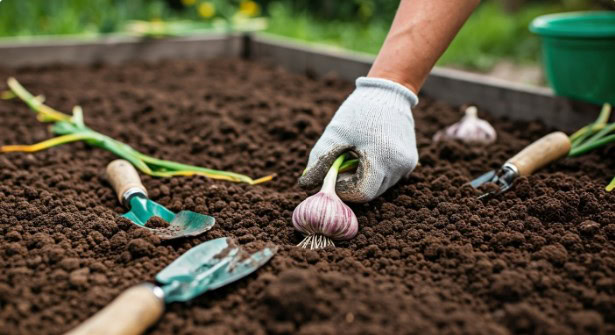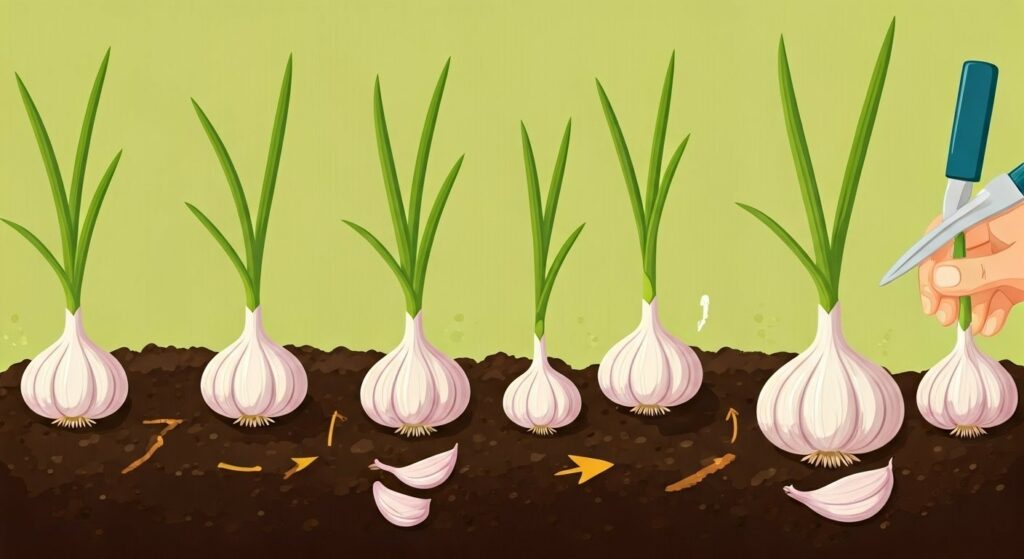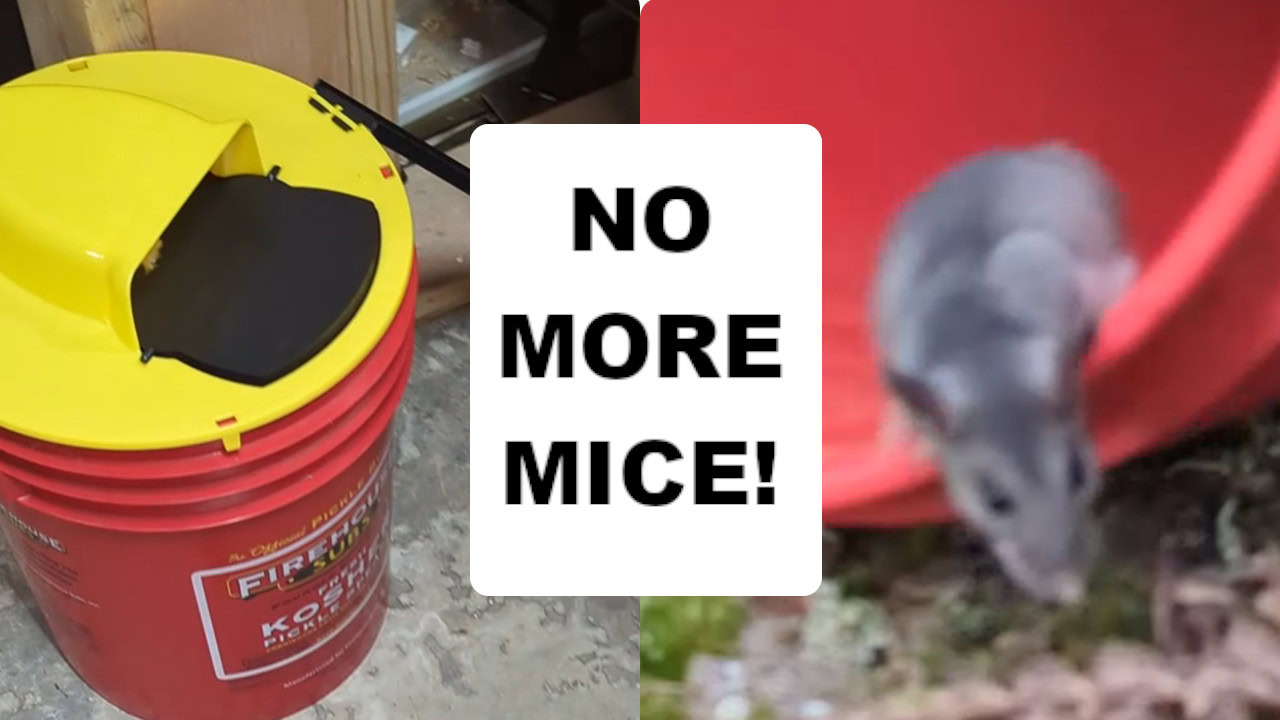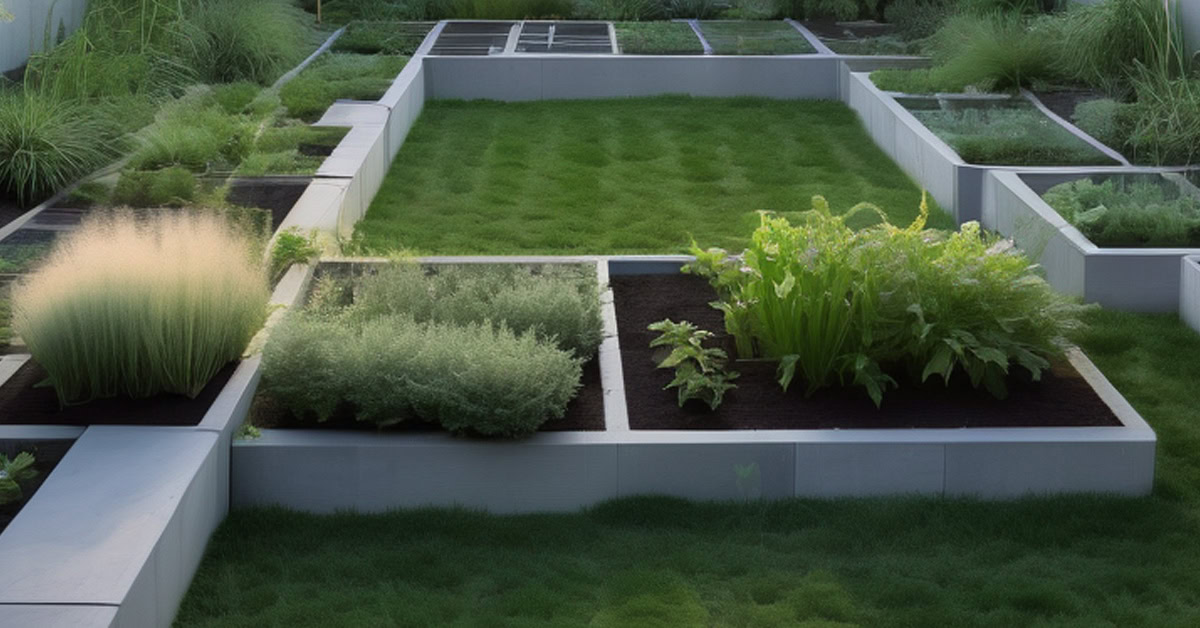Imagine the smell of fresh garlic bulbs filling your kitchen. It adds a wonderful scent and taste to many dishes. Growing your own garlic can be a great experience, but you need to understand the basics first. It might be easy to just take a garlic bulb from the grocery store and plant it in the ground, but getting a good harvest takes a little more skill! Let’s find out how to plant garlic successfully in your garden.
How Deep Should You Plant Garlic?
The short answer on how deep to plant garlic is 4″ in the fall and slightly shallower in the spring. Winter plantings in cold weather climates will benefit from the deeper planting as it protects the cloves over the winter. Beyond depth, there are several other important factors that contribute to successful garlic gardening though.
Understanding Garlic Planting Basics

Planting garlic is like hiding a treasure in the ground, waiting for nature to work its magic. To garden successfully, it’s important to know when, where, and how deep to plant.
Garlic grows best in cooler weather, so fall is usually the best time to plant in most places. If you live where winters are mild, you can also plant in spring. No matter when you plant, it is very important to know how deep to plant the bulbs. This helps garlic grow well and develop big bulbs.
The Best Time to Plant Garlic
When you want to plant garlic, timing is very important! For gardeners in places with clear seasons, fall is the best time to plant. You should try to plant garlic cloves about 6 to 8 weeks before the first frost. This gives the cloves a good amount of time to grow strong roots before the cold weather starts. They won’t waste energy growing above ground during this time.
So why is fall planting good? It helps garlic go through a process called vernalization. This is when they get cold exposure, which is important for forming bulbs. This chilly time makes sure your garlic is ready to grow quickly in spring.
If you live in a warm place where the ground doesn’t freeze, you can plant in spring instead. Just remember, the bulbs may be a bit smaller than those planted in fall. However, you will still enjoy a homegrown harvest!
Choosing the Right Garlic for Your Garden
Before you start growing garlic, it’s important to pick the right garlic seed for your garden. There are two main types: hardneck and softneck garlic. They each have different traits and climate needs. This helps you grow a healthy garlic patch that suits your area.
Hardneck varieties grow a thick stalk called a “scape” that creates flower heads. They are loved for their strong taste and big cloves. Some well-known hardneck types are ‘Music,’ which has big, creamy white cloves, and ‘Spanish Roja,’ famous for its sweet and strong flavor.
If you live in a place with milder winters, softneck varieties are a great option. They can be stored for a longer time than hardnecks and make larger bulbs, but they have smaller cloves. A popular softneck type found in stores is ‘California White Early.’ Another favorite is the heirloom ‘Lorz Italian,’ which is known for its spicy and bold taste.
Preparing Your Garlic for Planting
Your garlic cloves are ready for their journey from clove to bulb. But, it is important to prepare them well! Now is the moment to check, pick, and give them a boost before placing them in their garden bed.
This step is about giving your garlic the best start possible. By choosing healthy cloves and making good soil, you help them have the best chance to grow and create a large harvest.
Selecting Quality Garlic Cloves
Starting with good garlic cloves is very important for a great harvest, just like planting seeds for a beautiful flower bed. Don’t use garlic bulbs from the grocery store. They often have treatments to keep them fresh, which can hurt their ability to grow.
Instead, look for seed garlic at a good local nursery, a farmer’s market, or an online seed seller. These places usually have many types of garlic that are healthy and meant for planting.
When you pick your cloves, remember that bigger is better! Choose the largest, firm cloves from the bulbs. Make sure they are healthy, without spots, and not sprouting. A strong clove lays the groundwork for a strong garlic plant.
Pre-Planting Treatments for Healthier Growth
Before planting your garlic cloves, think about giving them some extra care. While it is not necessary, these easy steps can improve the soil and help the roots grow strong. This can lead to healthier garlic.
Start with a soil test. This will show you if there are any nutrients missing and help you choose what to add. Garlic grows best with phosphorus and potassium, so adding bone meal or wood ash to the soil can really help.
Another good idea is to soak your garlic cloves in a weak solution of seaweed extract or fish emulsion for a few hours before you plant them. These natural fertilizers give your plants micronutrients. This can help roots grow and make the plants stronger overall.
A Step-by-Step Guide to Planting Garlic

Now that your garlic cloves are ready, it’s time to plant them in your garden! This part will guide you on how to plant them. Following this guide will help each clove grow well and develop strong bulbs.
It’s important to give enough space between cloves and to plant them at the right depth. This helps air reach them and allows nutrients to get in, which leads to a good harvest. Let’s start planting!
Step 1: Soil Preparation
Garlic grows best in a sunny spot, like someone relaxing on the beach. It needs well-drained soil and 6 to 8 hours of direct sunlight each day.
After picking a sunny place, you should prepare the garden soil. Garlic does well in loose, fertile soil that drains well. To help with this, add a good layer of compost or aged manure to the top 6 to 8 inches of soil.
If you want more nutrients, you can use a balanced, slow-release fertilizer by following the instructions on the package. This will give garlic the nutrients it needs during its growing season.
Step 2: How Deep to Plant Your Garlic
The depth at which you plant those precious garlic cloves plays a pivotal role in their success. Plant them too shallow, and they risk frost damage; plant them too deep, and they may struggle to emerge. The sweet spot? Aim for a planting depth of about 4 inches.
Positioning is also key! Ensure each garlic clove is planted in an upright position, with the pointed end facing up and the wider root end facing down. This ensures the shoots emerge easily while encouraging proper bulb formation beneath the soil.
To simplify the process, here’s a handy table illustrating the ideal planting depth and spacing:
| Aspect | Recommendation |
| Planting Depth | 4 inches |
| Spacing Between Cloves | 4-6 inches |
| Spacing Between Rows | 12-18 inches |
Step 3: Spacing Guidelines for Optimal Growth
While you might want to plant a lot of garlic cloves close together, it’s important to give them enough space. Space helps garlic grow better. It ensures good airflow, lowers the chance of fungal diseases, and lets each plant get the nutrients it needs.
A simple rule is to plant garlic cloves about 4 to 6 inches apart in rows. This gives them room to form strong bulbs.
Make sure to leave about 12 to 18 inches between each row. This way, you can easily walk through for weeding and harvesting. When you give enough space, your garlic plants will have better air circulation. This helps prevent disease and leads to a more successful harvest.
Caring for Your Garlic Post-Planting
With your garlic safely planted, it’s time to focus on taking care of them. Don’t worry, garlic plants are easy to grow and don’t need a lot of care.
A bit of attention can help your garlic plants thrive and produce well. Keep an eye on how much water they need. Also, make sure to protect them from weeds. This way, you’ll be ready to enjoy a great harvest.
Watering Your Garlic Plants
Garlic plants can handle dryness, but they need regular watering for their best growth, especially when the bulbs are forming. Try to give them about an inch of water every week. This can come from rain or additional watering.
You should change how much you water based on your climate and how much it rains. If it is dry or your garlic plants are growing quickly, they might need more water. If you get a lot of rain, you might not need to water them much.
As the growing season goes on and the weather gets warmer, start watering less often. This helps the bulbs become stronger and get ready for harvest.
Mulching and Weed Control
Mulching is like making your garlic plants cozy for the winter. It has many benefits. After you plant the garlic, put a 2 to 3-inch layer of organic mulch around them. You can use materials like straw, shredded leaves, or grass clippings.
This mulch keeps moisture in the soil, stops weeds from growing, and helps the soil stay at a stable temperature. As the mulch breaks down, it adds good organic matter to the soil. This improves the soil’s structure and fertility.
Weeds can take nutrients and moisture from your garlic plants. They compete with them and can make your plants unhealthy. It’s important to control weeds regularly to keep a healthy garlic patch. You can pull weeds by hand or use a hoe around the garlic plants to keep weeds away.
Conclusion
In conclusion, planting garlic at the right depth is very important for it to grow well. Use the tips in this blog to help your garlic do well in the garden. It’s essential to prepare the soil, keep enough space between plants, and care for them after planting. By knowing the basics of planting garlic and caring for your plants, you can enjoy fresh, tasty garlic from your garden. Happy planting!
Frequently Asked Questions
Can garlic be planted in containers?
Many types of garlic grow well in containers. This makes them great for balcony gardening or small spaces. Choose a pot that drains well. It should also be deep enough, at least 12 inches, to hold the bulbs.
What is the best fertilizer for garlic?
Garlic plants need a balanced fertilizer. It’s important to understand what they need for nutrients. Organic choices, such as compost and blood meal, work really well. Using a synthetic source of nitrogen in early spring can give them an extra boost.




